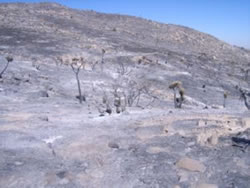
National Fire Plan Success Story
Firefighters Attack Lightning Fires in Park
Joshua Tree National Park, California
National Fire Plan - Firefighting
2010

Joshua trees scorched by intense heat.
Fire is a rare visitor to southern California’s Mojave Desert. On August 26, 2010, lightning strikes generated by an intense storm cell ignited three small wildfires at Joshua Tree National Park. One of these fires, near the Keys View Overlook eventually burned 114 acres in desert brush and juniper habitat. The other two fires quickly burned out.
The Keys fire burned in rugged terrain and posed no threat to buildings or private property. The fire, however, burned adjacent to a popular park viewpoint and the road to this viewpoint was closed for five days while firefighting efforts continued. Engines crews, ground crews and aerial units quickly responded to battle the blaze.
An incident command structure was rapidly established and by the following morning, a full scale command post became operational. At the peak of firefighting efforts, a total of 75 firefighters and logistical support staff were engaged in the suppression effort. That same morning, crews had put in a 4-foot wide handline around the fire and by the morning of August 29, it was fully contained.
By the afternoon of August 29, staff from the park’s resource management division were assessing the fire area and developing a plan for the rehabilitation of the fire scene.
Initial estimates indicate a reduction of vegetative ground cover from sixty percent to three percent. This reduced cover leaves the area prone to erosion and gives invasive, non-native species an opportunity to become established.
During the next several months, resource management crews will be testing the effectiveness of two herbicides to control exotic species to give native plants a chance to recover from the fire.
In addition, native plants seeds from the surrounding area are being collected and propagated in the park nursery for planting in the spring and fall over the next two years.
Josh Hoines, the park vegetation branch chief stated, “…we will monitor all treatments for effectiveness over the next three years to assure our plan successfully rehabilitates the burned area.”
Contact: Patrick Pilcher, Park Ranger, (760) 367-5523.